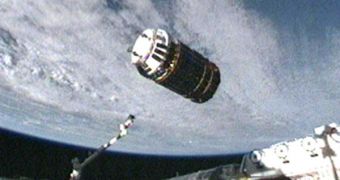Finally, after more than seven days of orbital chase, Japan's new H-2 Transfer Vehicle 1 (HTV-1) caught up with the International Space Station (ISS), and was captured with the orbital outpost's robotic arm. The new space freighter, which was developed by the Japanese space agency JAXA, had a flawless inaugural flight, with its picture-perfect launch taking place on September 11th. Everything went according to plan, although many things could have gone wrong, especially considering the fact that the vehicle launched atop a new H-2B delivery system, a major upgrade from its predecessor.
“HTV-1 is opening up new horizons for JAXA's undertaking of human spaceflight. I like to say that JAXA is now entering a new era,” JAXA's Houston Office Deputy Director, Masazumi Miyake, said before the launch. The two spacecraft met while flying 225 miles (365 km) above western Romania, and ISS flight engineer Nicole Stott used the station's robotic arm to pluck the space freighter from orbit. The new module is not capable of maneuvering itself to a dock, therefore it must be handled from within the space facility, Space reports.
“It just looks fantastic. We're going to get some pictures and some video, full coverage of this,” Stott told the Mission Control, as the six-astronaut crew aboard the ISS watched the new cargo ship, filled with three and a half tons of supplies, being maneuvered alongside the station. “We had an amazing time doing this, we're so happy to have this beautiful vehicle here. We look very [much] forward to going in tomorrow and finding all the supplies that I'm sure you've stored there for us,” Stott said at 3:47 pm EDT (1947 GMT), after completing the HTV-1 capture-and-dock procedures.
The ISS flight engineer only had 99 seconds to trap the Japanese cargo ship, before it moved past the station and into another orbit. It flew nine meters (30 feet) away from the lab, so Stott's work had to be extremely precise and effective. The astronauts then toasted to the successful completion of Japan's first such test with a glass of recycled water. “After the space shuttle starts to fade away, we will take over responsibility to bring stuff up to the space station. We're really looking forward to the success of this mission,” Japanese astronaut Soichi Noguchi, who is scheduled to launch to the ISS in December, said before HTV-1's arrival.

 14 DAY TRIAL //
14 DAY TRIAL //